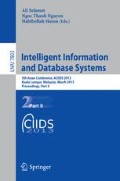Abstract
Short-interfering RNAs (siRNAs) suppress gene expression through a process called RNA interference (RNAi). Current research focuses on finding design principles or rules for siRNAs and using them to artificially generate siRNAs with high efficiency of gene knockdown ability. Design rules have been reported by analyzing biology experiments and applying learning methods. However, possible good design rules or hidden characteristics remain undetected. In contribution to computational methods for finding design rules which are mostly employed by discriminative learning techniques, in this paper we propose a novel descriptive method to discover two design rules for effective siRNA sequences with 19 nucleotides (nt) and 21 nt in length that have important characteristics of previous design rules and contain new characteristics of highly effective siRNA. The key idea of the method is first to transform siRNAs to transactions then apply an Apriori adaptation with automatic min_support values to detect descriptive rules for effective and ineffective siRNAs. Rational design rules are created by analyzing graphical representations of descriptive rules. Experimental evaluation on the two siRNA data sets including 5737 siRNA sequences shown that our design rules are promising to design siRNAs effectively.
Access this chapter
Tax calculation will be finalised at checkout
Purchases are for personal use only
Preview
Unable to display preview. Download preview PDF.
References
Elbashir, S.M., Lendeckel, W., Tuschl, T.: RNA interference is mediated by 21– and 22–nucleotide RNAs. Genes Dev. 15, 188–200 (2001)
Elbashir, S.M., Martinez, J., Patkaniowska, A., Lendeckel, W., Tuschl, T.: Functional anatomy of siRNAs for mediating efficient RNAi in Drosophila melanogaster embryo lysate. EMBO J. 20, 6877–6888 (2001)
Elbashir, S.M., Harborth, J., Weber, K., Tuschl, T.: Analysis of gene function in somatic mammalian cells using small interfering RNAs. Methods 26, 199–213 (2002)
Scherer, L.J., Rossi, J.J.: Approaches for the sequence-specific knockdown of mRNA. Nat. Biotechnol. 21, 1457–1465 (2003)
Reynolds, A., Leake, D., Boese, Q., Scaringe, S., Marshall, W.S., Khvorova, A.: Rational siRNA design for RNA interference. Nat. Biotechnol. 22(3), 326–330 (2004)
Ui-Tei, K., Naito, Y., Takahashi, F., Haraguchi, T., Ohki-Hamazaki, H., Juni, A., Ueda, R., Saigo, K.: Guidelines for the selection of highly effective siRNA sequences for mammalian and chick RNA interference. Nucleic Acids Res. 32, 936–948 (2004)
Amarzguioui, M., Prydz, H.: An algorithm for selection of functional siRNA sequences. Biochem. Biophys. Res. Commun. 316(4), 1050–1058 (2004)
Hsieh, A.C., Bo, R., Manola, J., Vazquez, F., Bare, O., Khvorova, A., Scaringe, S., Sellers, W.R.: A library of siRNA duplexes targeting the phosphoinositide 3-kinase pathway: determinants of gene silencing for use in cell-based screens. Nucleic Acids Res. 32(3), 893–901 (2004)
Jagla, B., Aulner, N., Kelly, P.D., Song, D., Volchuk, A., Zatorski, A., Shum, D., Mayer, T., De Angelis, D.A., Ouerfelli, O., Rutishauser, U., Rothman, J.E.: Sequence characteristics of functional siRNAs. Rna 2005 11(6), 864–872 (2005)
Chalk, A.M., Wahlestedt, C., Sonnhammer, E.L.L.: Improved and automated prediction of effective siRNA. Biochem. Biophys. Res. Commun. 319, 264–274 (2004)
Teramoto, R., Aoki, M., Kimura, T., Kanaoka, M.: Prediction of siRNA functionality using generalized string kernel and support vector machine. FEBS Lett. 579, 2878–2882 (2005)
Ladunga, I.: More complete gene silencing by fewer siRNAs: Transparent optimized design and biophysical signature. Nucleic Acids Res. 35, 433–440 (2007)
Huesken, D., Lange, J., Mickanin, C., Weiler, J., Asselbergs, F., Warner, J., Mellon, B., Engel, S., Rosenberg, A., Cohen, D., Labow, M., Reinhardt, M., Natt, F., Hall, J.: Design of a Genome-Wide siRNA Library Using an Artificial Neural Network. Nature Biotechnology 23(8), 955–1001 (2005)
Pei, Y., Tuschl, T.: On the art of identifying effective and specific siRNAs. Nat. Methods 3, 670–676 (2006)
Takasaki, S.: Efficient prediction methods for selecting effective siRNA sequences. Comput. Biol. Med. 40, 149–158 (2010)
Author information
Authors and Affiliations
Editor information
Editors and Affiliations
Rights and permissions
Copyright information
© 2013 Springer-Verlag Berlin Heidelberg
About this paper
Cite this paper
Ngoc, B.T., Ho, T.B., Saori, K. (2013). A Descriptive Method for Generating siRNA Design Rules. In: Selamat, A., Nguyen, N.T., Haron, H. (eds) Intelligent Information and Database Systems. ACIIDS 2013. Lecture Notes in Computer Science(), vol 7803. Springer, Berlin, Heidelberg. https://doi.org/10.1007/978-3-642-36543-0_21
Download citation
DOI: https://doi.org/10.1007/978-3-642-36543-0_21
Publisher Name: Springer, Berlin, Heidelberg
Print ISBN: 978-3-642-36542-3
Online ISBN: 978-3-642-36543-0
eBook Packages: Computer ScienceComputer Science (R0)

